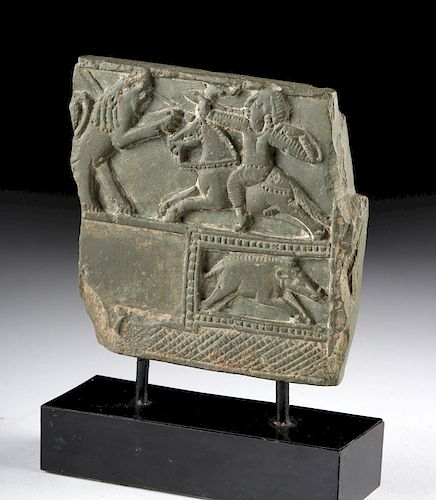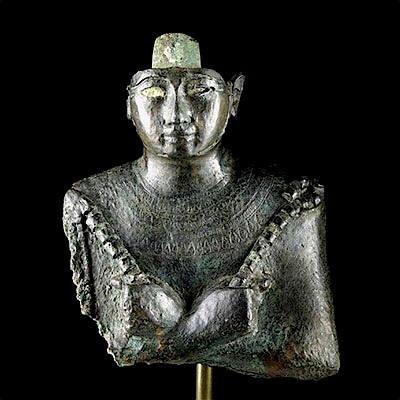Urartian Stone Relief Panel with Hunter and Boar
Lot 71a
About Seller
Artemis Gallery
686 S Taylor Ave, Ste 106
Louisville, CO 80027
United States
Selling antiquities, ancient and ethnographic art online since 1993, Artemis Gallery specializes in Classical Antiquities (Egyptian, Greek, Roman, Near Eastern), Asian, Pre-Columbian, African / Tribal / Oceanographic art. Our extensive inventory includes pottery, stone, metal, wood, glass and textil...Read more
Estimate:
$3,500 - $5,000
Absentee vs Live bid
Two ways to bid:
- Leave a max absentee bid and the platform will bid on your behalf up to your maximum bid during the live auction.
- Bid live during the auction and your bids will be submitted real-time to the auctioneer.
Bid Increments
| Price | Bid Increment |
|---|---|
| $0 | $25 |
| $300 | $50 |
| $1,000 | $100 |
| $2,000 | $250 |
| $5,000 | $500 |
| $10,000 | $1,000 |
| $20,000 | $2,500 |
| $50,000 | $5,000 |
| $100,000 | $10,000 |
| $200,000 | $20,000 |
About Auction
By Artemis Gallery
May 22, 2019
Set Reminder
2019-05-22 10:00:00
2019-05-22 10:00:00
America/New_York
Bidsquare
Bidsquare : Exceptional Day 1: Antiquities Asian Fine Art
https://www.bidsquare.com/auctions/artemis-gallery/exceptional-day-1-antiquities-asian-fine-art-4129
Day 1 of an important 2-day auction featuring exceptional art from around the world - Egyptian, Greek, Etruscan, Roman, Viking, Russian, Near Eastern; Asian Art from China, Japan, Thailand, Vietnam, Burma, India; Fine Art from the 17th century to present. Artemis Gallery info@artemisgallery.com
Day 1 of an important 2-day auction featuring exceptional art from around the world - Egyptian, Greek, Etruscan, Roman, Viking, Russian, Near Eastern; Asian Art from China, Japan, Thailand, Vietnam, Burma, India; Fine Art from the 17th century to present. Artemis Gallery info@artemisgallery.com
- Lot Description
Ancient Near East, modern day Eastern Anatolia region of Turkey, Urartu, Urartian, Iron Age III, ca. 7th century BCE. A mesmerizing relief section, skillfully carved on a rich dark green stone. The composition depicts an action-packed hunting scene - the hunter on horseback is aiming his bow and arrow at a rearing ferocious lion - below is a panel featuring a boar in profile facing right and framed by a dotted border, with a cross-hatched register underscoring it. The hunting scene is replete with wonderful details - note the lion's curly mane, sharp claws, and curled tail as well as the horse's neatly manicured plaited mane and scallop-edged bridle. Clearly the artist was interested in conveying the drama and excitement of this event! Size: 3.375" W x 3.375" H (8.6 cm x 8.6 cm); 4.5" H (11.4 cm) on included custom stand.
The civilization of Urartu was one of several states that arose following the destruction of the Hittite state in approximately 1200 BCE. Others included Tabal, Phrygia, and Lydia - each one possessed its own distinct language, religion, ethnicity, and visual culture. According to the Metropolitan Museum of Art Heilbrunn essay, "In their inscriptions, the Assyrians of Mesopotamia refer to the Urartians as their northern enemies from the eleventh to the seventh centuries B.C. However, the earliest known Urartian written document, a rock inscription at Van (ancient Tushpa), records the earliest reference to the state. There it says that Urartu was ruled by a king named Sarduri (r. ca. 840–830 B.C.), and mentions a male deity, Haldi, the supreme god throughout Urartian history."
Provenance: private East Coast, USA collection; ex-Frances Artuner collection, Belgium, acquired in the 1960s
All items legal to buy/sell under U.S. Statute covering cultural patrimony Code 2600, CHAPTER 14, and are guaranteed to be as described or your money back.
A Certificate of Authenticity will accompany all winning bids.
We ship worldwide and handle all shipping in-house for your convenience.
#146203A section from a larger relief panel with losses to peripheries as shown. Encrustations on the verso as well as a rectangular stain from old collection label as shown.Condition
- Shipping Info
-
All shipping is handled in-house for your convenience. Your invoice from Artemis Gallery will include shipping calculation instructions. If in doubt, please inquire BEFORE bidding for estimated shipping costs for individual items.
-
- Buyer's Premium



 EUR
EUR CAD
CAD AUD
AUD GBP
GBP MXN
MXN HKD
HKD CNY
CNY MYR
MYR SEK
SEK SGD
SGD CHF
CHF THB
THB














